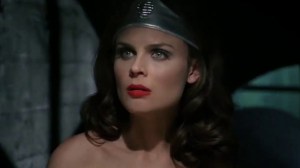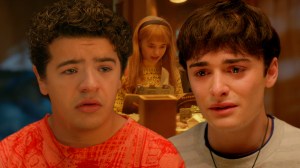Later this month, Archie Comics will reboot Josie and the Pussycats with a new #1 issue from an all-star creative team aimed at bringing the property into line with their popular “New Riverdale” publishing line.
Videos by ComicBook.com
Following the successes of Archie, Jughead, and Betty & Veronica, the publisher will bring another batch of characters to the fore — one that has a slightly different fan base than the traditional Archie characters.
If you’re a regular Archie reader, Josie and the Pussycats is an odd animal. It’s very much part of the tapestry of the Riverdale/Archie universe, but the Pussycats have fans outside of comics who know the characters primarily from the animated series or the smart, seditious 2001 movie and don’t realize “Oh, wait…that ‘Riverdale’ they’re talking about is the one from Archie? That dynamic should, of course, start to wear off a bit when Josie McCoy and company come to The CW’s Riverdale next year and interact with Archie and the gang on the small screen — but for now, the Josie and the Pussycats reboot embraces it a little bit.

From writers Marguerite Benett and Cameron DeOrdio with artist Audrey Mok, Josie and the Pussycats manages — arguably more than any previous New Riverdale release — to truly capture the spirit of classic Archie Comics while still embracing the diversity of style and content offered by the New Riverdale initiative.
Its first issue feels like an episode of the cartoon — or, if not the classic Josie cartoon, it at least feels like an episode of a cartoon. It has all the elements that you expect from the series, with a significantly larger role this time around for Alexandra than it seems like she’s had in most previous iterations.
[Ed. note: Full disclosure on that last point: My primary interest in Josie comes from the 2001 movie, in which Alexandra Cabot was really an afterthought. Her best line is when she’s asked what she’s even doing in the movie, to which she responds…]

That feeling is a bit different from the tone of Archie, which has felt like a longer, ongoing story from the first issue. It’s also different from the somewhat more contained Jughead, in that Jughead has a more absurdist tone. There’s a sense of non-stop movement in Josie and the Pussycats, driven in part by the character of Melody, who is a fun, funny ball of kinetic energy.
If there’s one weakness to the first issue, it’s the high concept: giving fans an opportunity to see the genesis of the band is a cool idea, but not necessarily one that strengthens a first issue already crowded by introducing all of the characters and concepts of the story. The execution is as good as it can be, and the character work is wonderful, but the audience already knows that the band is going to get together — the comic is called Josie and the Pussycats, after all — so the narrative real estate spent putting it all in place could arguably have been spent elsewhere.
That’s a minor quibble, though, and probably born out of expectations from other media (both the animated series and the 2001 movie caught up with the Pussycats once they’re already together, and so does Riverdale when it premieres in January). Exploring territory that hasn’t been done in previous versions is probably nothing to be maligned.
Mok’s artwork is a high point of the issue: as promised in interviews with both Archie President and Editor Mike Pellerito and with the Josie and the Pussycats writing team, the book delivers the kinetic spirit of a live music show in a way that’s hard to do.
The series’ art has that element that artists like Tak Miyazawa and Terry Moore manage so well, vascillating between something more grounded in the real world and tropes more familiar to classic American and Japanese animation.
It’s both Mok’s handling of the live music and her facial expressions that elevate the crackling dialogue.

The songs are cleverly written and a nice way of conveying some tone and subtext, but one of the reason the soundtrack works so well in the cartoons and movie is that you actually hear the music. Without seeing even sheet music (like what Terry Moore used to do occasionally in Strangers in Paradise), trying to imagine what the music might sound like can take you out of the narrative a little bit. There’s ups and downs to that, obviously: while music taking you out of the world you inhabit and allowing you to mentally “be” somewhere else is something that songwriters aspire to, anything that distracts from your primary narrative can be a source of frustration for storytellers.
Maybe the best bit is the increased role of Pepper, who has been around for as long as Josie has but rarely gets the same play as other Riverdale regulars. Here, she’s probably the most likable non-Pussycat in the book, and it’s clear there’s a lot to explore there. She’s key to the way the Sorkin-like dialogue pops in the first chunk of the book, and her relationship with Josie is key to setting up why she (Josie) is the title and point-of-view character even though later in the issue we’re repeatedly told that the other Pussycats have more to offer.
The first issue of the new Josie and the Pussycats is a fun, smart, lovable reintroduction of some of Riverdale’s best and most versatile characters. It’s beautifully-illustrated, featuring fresh, interesting, and fun takes on beloved characters. It offers a story which, while somewhat overburdened for its page count, promises great things on the horizon. Get excited for Josie and the Pussycats, and reach out to your retailer about it before the final order cutoff window closes tomorrow.








